-
Products
- Lab Instruments
-
Lab Meters and Probes
Calibration Standards Other Meters and Probes
- Chemistries, Reagents, and Standards
-
Online Analyzers
Ammonium Analysers Chlorine Analyzers
- CL17sc
- CL10sc Amperometric
- 9184 sc Amperometric
- Ultra Low Range CL17sc Colorimetric Chlorine Analyser
EZ Series Analysers- Iron
- Aluminium
- Manganese
- Phosphate
- Chloride
- Cyanide
- Fluoride
- Sulphate
- Sulphide
- Arsenic
- Chromium
- Copper
- Nickel
- Zinc
- Ammonium
- Total Nitrogen
- Total Phosphorus
- Phenol
- Volatile Fatty Acids
- Alkalinity
- ATP
- Hardness
- Toxicity
- Sample Preconditioning
- Boron
- Colour
- Nitrate
- Nitrite
- Silica
- Hydrogen Peroxide
- EZ Series Reagents
- EZ Series Accessories
- EZ sc Series Inorganics
- EZ sc Series Metals
- EZ sc Series Nutrients
-
Online Sensors and Controllers
Digital Controllers (Transmitters) Controllers (Analog)
- SC4500
- Orbisphere 410/510 Carbon Dioxide
- Orbisphere 410/510 Oxygen
- Orbisphere 410/510 Ozone
- Pro Series
pH & ORP Sensors- 1200-S pH
- 12mm pH/ORP
- 8362 sc High Purity
- Combination pH/ORP
- Differential pH
- Digital Differential ORP
- Digital Differential pH
- LCP ORP
- LCP pH
Dissolved Oxygen Sensors- 2582sc
- 5500 Clark DO
- 9582 sc
- LDO 2 sc
- Orbisphere 311xx
- Orbisphere GA2x00
- Orbisphere K1X00
- Orbisphere M1100
- Orbisphere Oxygen ppb
Conductivity Sensors- 3400 Analogue Contacting
- 3400 Digital Contacting
- 3700 Analogue Inductive
- 3700 Digital Inductive
- 3798 sc Electrodeless
- 9523 Cation Conductivity
- 9525 DCCP System
- Samplers
- Multiparameter Online Panels
- Test Kits & Strips
-
Microbiology
Accessories and Chemicals Dehydrated MediaInstruments KitsLabware
- Automated Lab Systems
-
Lab Equipment and Supply
Apparatus
- Brushes
- Clamps, Rings & Stands
- Crucibles
- Crucibles & Casseroles
- Dispensers & Droppers
- Grab Samplers
- Oil and Grease
- Other Apparatus
- Pipet Aids
- Pipettes
- Racks
- Stir Bars
- Tubing
- Weighing Accessories
General Lab Consumables Glassware/PlasticwareInstruments- Balances
- Hot Plates & Stirrers
- Microscopes
- Moisture Analysers
- Other Instruments
- Ovens & Incubators
- Thermometers
- Timers
- Vacuum Pump
- Industrial UV
- Flow and Collections
- Electrochemistry
- Parameters
- Industries
- Support
- Service
- e-Shop
Hach India
Choose your country or region:
Europe
Americas
Asia - Australasia
- Australia
- Mainland China
- India
- Indonesia
- Japan
- Malaysia
- New Zealand
- Philippines
- Singapore
- South Korea
- Thailand (Thai)
- Taiwan
- Vietnam
Middle East - Africa
Promotions INQUIRY: +91 9916040249
Portable, Laboratory and UV-VIS Spectrophotometers
Water Quality Tests you can Trust Every Time
Maintain regulatory compliance and stable plant operations
For over half a century, Hach ® has been your partner in water analysis with spectrophotometers, offering:
- Greatest variety of approved methods.
- Patented built-in error protection.
- Compatibility with Hach’s leading chemistries.
- Portable and laboratory solutions to meet every application and budget.

What is a Spectrophotometer?
A spectrophotometer is an instrument that measures how much light is absorbed by a water sample as light passes through it.
After adding chemical reagents to a water sample, those reagents react with analyte(s) to form a color complex. Spectrophotometers then use internal calibrations to equate that color to the concentration of the parameter being measured.
Spectrophotometry is one of the most common and useful methods of quantitative analysis of many water parameters in various industrial and municipal applications.
Types of Spectrophotometers
Choose Hach portable or benchtop laboratory spectrophotometers (VIS or UV-VIS) in combination with Hach reagents for accuracy and optimal water quality assurance.
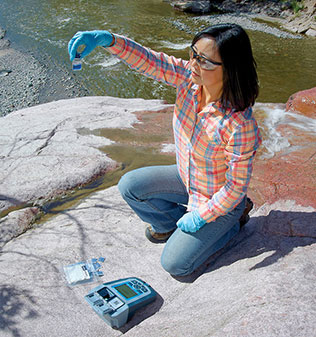
Portable spectrophotometers
Portable, handheld spectrophotometers allow you to analyze water samples in the field.
If you primarily operate in a mobile environment, Hach portable spectrophotometers offer quality and accuracy to your measurements in a rugged, compact, user-friendly package.
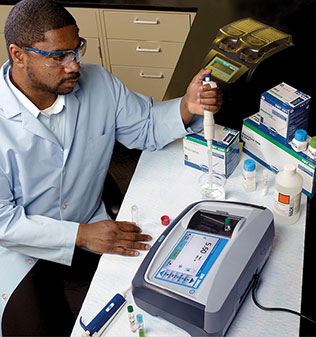
Laboratory spectrophotometers
Lab spectrophotometers measure light absorbance across the visible ranges of the electromagnetic spectrum. Ideal for high-volume water analysis needs.
Our user-friendly benchtop spectrophotometers are pre-programmed with over 250 methods optimized for laboratory water analysis.
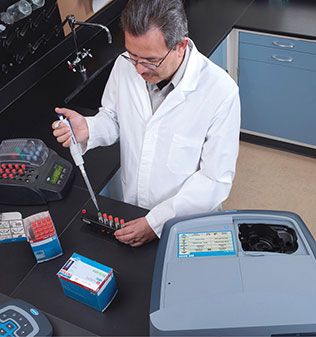
UV-VIS laboratory spectrophotometers
UV-VIS lab spectrophotometers measure light absorbance across the ultraviolet and visible ranges of the electromagnetic spectrum.
Our UV-VIS instruments have guided procedures and include pre-programmed testing methods and our integrated quality assurance software – Claros™, The Water Intelligence System from Hach.
Get the Right Spectrophotometer to Meet Your Needs
Portable/Handheld Spectrophotometers
DR1900 Portable Spectrophotometer
With a simple user interface that makes testing easier than ever, the DR1900 is best in class accuracy and portability.
Light and compact, the DR1900 is built for demanding, rugged conditions, and it's flexible - accepting the widest range of vial sizes.
It also includes over 220 of the most commonly tested pre-programmed methods already built in.
DR1900 Portable Spectrophotometer with USB + Power Module
Bundle your DR1900 Portable Spectrophotometer with USB and power module (LZV813) allowing for data transfer and line power options.
With over 220 pre-programmed methods in a waterproof, rugged design, the DR1900 delivers lab quality results in a portable, field ready instrument.
Shop NowLaboratory Spectrophotometers
DR3900 Benchtop Spectrophotometer without RFID Technology*
The DR3900 is a benchtop visible spectrum (320 - 1100 nm), split beam spectrophotometer with over 220 pre-programmed methods optimized for laboratory water analysis, safe processes, and accurate results.
This instrument connects to Claros™, Hach’s innovative Water Intelligence System, enabling you to seamlessly connect and manage instruments, data, and process – anywhere, anytime.
Shop NowUV-VIS Spectrophotometers
DR6000 UV VIS Spectrophotometer without RFID
A benchtop UV-VIS (190 - 1100 nm), split beam spectrophotometer that offers high-speed wavelength scanning across the UV and Visible Spectrum.
As the industry’s most advanced lab spectrophotometer, it comes with over 250 pre-programmed methods. This instrument also connects to Claros™.
Shop NowFrequently Asked Questions
What is the difference between a colorimeter and a spectrophotometer?
Colorimeters (also referred to as Filter Photometers) and Spectrophotometers both measure sample absorbance to determine analyte concentrations. Colorimeters are usually portable and use LED light sources and color filters. As a result, they operate at fixed wavelengths and can only accommodate tests that incorporate those wavelengths.
Spectrophotometers are usually bench top instruments and use light sources that can produce a range of wavelengths. The spectrophotometers used by Hach use tungsten (or xenon) lamps to produce light in the visible spectrum and deuterium lamps to produce UV light. Spectrophotometers also use monochromators to select for a desired wavelength. As a result, spectrophotometers can be used for a broad range of tests.
The following table highlights the differences between Colorimeters and Spectrophotometers:
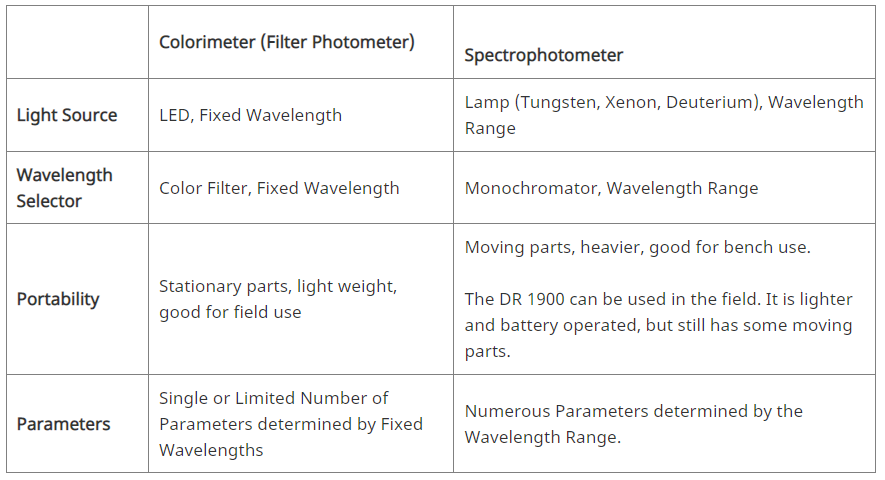
How is a calibration curve prepared in a colorimeter or spectrophotometer?
Hach colorimeters and spectrophotometers are carefully calibrated during manufacturing and do not require additional calibration. However, most of these instruments have user-entered calibration options for colorimetric tests if desired.
To calibrate an instrument for a particular test, put the instrument in absorbance mode, select the wavelength for the test, and prepare 3 to 10 different concentrations of standard solutions that span the full test range. Follow the Hach procedure (or your own procedure) to develop color in each standard, and the measure the absorbance of each standard in the instrument.
Most Hach instruments can record the absorbance and concentration of each standard, and then calculate a calibration curve. Refer to the instrument manual for instrument specific instructions. After the instrument is calibrated, it will calculate the concentration of unknown samples using the calibration curve.
What is the difference between the DR 3900 and DR 6000 Spectrophotometers?
The DR 6000 spectrophotometer has a UV lamp while the DR 3900 spectrophotometer does not. As a result, there are more programs on the DR 6000 than on the DR 3900.
The DR 6000 has a Carousel Holder 7 x 1 cm (Product # LZV902.99.00002) and a Carousel Holder 5 x 1 inch (Product # LZV902.99.00012), which can be purchased as optional accessories.
The DR 6000 also has optional software applications which are not available on the DR 3900. These include the Brewery Analysis Package (Product # LZV942), the Drinking Water Analysis Package (Product # LZV925), and the Enzymatic Food Analysis Software (Product # LZV943).
The DR 6000 has tighter specifications than the DR 3900. For example, the wavelength accuracy of the DR 6000 is ± 1 nm. The wavelength accuracy of the DR 3900 is ± 1.5 nm.
What is the factor to convert from PO4 to PO4-P?
To convert from units of orthophosphate (PO43-) to orthophosphate as phosphorus (PO4-P), multiply the value by 0.3261. To convert from orthophosphate as phosphorus (PO4-P) to orthophosphate (PO43-) divide the value by 0.3261.
Many Hach spectophotometers and colorimeters give the option to change the chemical form of the reported value. This number is a ratio of the atomic mass of the elements in the chemical form. This calculation does not change the concentration of phosphorus in the sample, it only changes the value in relation to the units it is expressed in.
For example: Changing a height from 6 feet to 72 inches, or to 183 cms, does not change the actual height, it only changes the units in which it is reported. They are all mathematically equivalent.
Are the DR 3900 and DR 6000 spectrophotometers compatible with WiFi/WLAN?
The spectrophotometer has a wired ethernet connection out of the box. In order to connect a DR 3900 or DR 6000 spectrophotometer to a WiFi Network/WLAN, a USB adapter must be used. Hach does not carry an adapter; however, adapters based off of RealTek RTL8187, such as Netgear WG111v3 and Trendnet TEW-424UB H/W:3.1R have been found to work.
Does Hach have an ultra-low range iron procedure for spectrophotometers?
Iron, Total FerroZine® Method, Method 10287_DOC316.53.01520 measures ultra-low range iron using FerroZine® and a standard 1" square glass sample cell on the DR3900, DR5000, or DR6000.
Why does a spectrophotometer need to be zeroed?
Spectrophotometers and colorimeters are zeroed or "blanked" to reset the absorbance baseline to any background color in the sample that may absorb at the wavelength in question causing an interference.
What is the advantage of using RFID with spectrophotometers?
The Radio Frequency Identification (RFID) system is designed to deliver accurate results by supporting the operator from sampling to sample preparation, sample analysis and documentation. By means of RFID technology one can trace samples completely back to the sampling point.
Lot number and expiry date information of the TNTPlus™ tests are logged into the spectrophotometer thanks to the 2D barcode. The RFID module reads out and displays all batch specific information from the test box. The batch certificate can be printed out immediately from the spectrophotometer using a printer.
Which instruments are compatible with TNT+ vials?
The DR1900, DR3900, and DR6000 are compatible with TNT+ chemistries.
To verify vial compatibility with any instruments please verify that the instrument is listed in the Instrument-specific information table in the full version of the method document.
Can the temperature of a sample affect a colorimetric test?
Yes this is possible. For example, a colder temperature could slow the chemical reaction and cause low results. Most methods are completed accurately when the sample temperature is between 20 and 25 ° C (68 to 77 °F).
Methods which are extremely temperature sensitive will have a note regarding any special temperature requirements in the full procedure.
What is the enclosure rating for Hach Spectrophotometers and Colorimeters? Enclosure ratings are denoted with an IP code that designates the resistance of an instrument to dust and water intrusion.
The first digit signifies the resistance to solid particles while the second digit signifies the resistance to liquid ingress. An "X" in the IP rating signifies the enclosure was not rated for that specification.
As an example, an IP-67 rating means that an instrument is dust proof and is waterproof for up to 30 minutes at a depth of 1 meter. Included in this article is a table of IP ratings for Hach Spectrophotometers and Colorimeters.
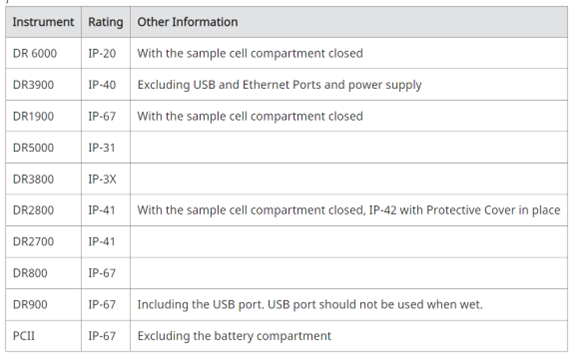
What information do the DR 3900 and DR 6000 Spectrophotometers read on the TNT+ boxes with RFID?
The TNT+ box includes updates to the calibration factors, including zero factors, as well as the Certificate of Analysis (COA). This information is read by DR 3900 and DR 6000 Spectrophotometers via RFID.
Which Hach spectrophotometers can read ultraviolet wavelengths?
The DR 6000 UV VIS Spectrophotometer is the only current Hach spectrophotometer with a UV lamp to read samples in the ultraviolet spectrum.
What Are the Differences Between Dr6000 and Dr3900 and Which One Is Best Suited for My Lab?
The key difference between the Hach DR6000 and the Hach DR3900 spectrophotometers lies in their capabilities and features. The Hach DR6000 spectrophotometer has a higher wavelength range than the Hach DR3900 spectrophotometer, with a range of 190-1100 nm compared to the DR3900's range of 320-1100 nm. Additionally, the DR6000 has a higher resolution than the DR3900, making it more suitable for advanced research applications.
On the other hand, DR3900 spectrophotometer is equipped with RFID technology that simplifies calibration procedures, making it a popular choice for routine laboratory testing. This powerful instrument can also measure multiple parameters simultaneously, which is a valuable feature for labs that need to perform multiple tests on a single sample.
When it comes to choosing the best-suited spectrophotometer for a lab, the decision will depend on the lab's specific needs and applications. If the lab requires a high level of accuracy and resolution for advanced research purposes, the Hach DR6000 would be the better choice. On the other hand, if the lab needs a spectrophotometer for routine testing with a simple calibration process and simultaneous measurement capabilities, the Hach DR3900 would be a more practical option.
How does a Portable Spectrophotometer help?
DR 1900 portable spectrophotometer is a cutting-edge instrument designed for field measurements of water quality. Its portable design allows for quick and convenient measurements of critical parameters, such as chlorine, pH, and dissolved oxygen, ensuring accurate data collection for water quality analysis.
One of the key benefits of the DR 1900 is its rugged construction, which makes it ideal for use in harsh environmental conditions. Its waterproof design allows it to be used in wet environments, and it is drop-tested to ensure it can withstand accidental drops.
The DR1900 Portable Spectrophotometer also has a user-friendly interface, which makes it easy to operate even for those without extensive technical knowledge. The instrument's large, backlit display ensures that results can be easily read, even in low-light environments.
Another significant advantage of the DR 1900 is its versatility. It can measure over 120 different water quality parameters, including ammonia, nitrate, and phosphorus. The DR 1900 also has a unique cuvette holder that allows for testing of large sample sizes, which is critical for applications such as wastewater treatment.
Overall, the DR 1900 portable spectrophotometer is an invaluable tool for water quality testing. Its rugged design, ease of use, and versatility make it an ideal choice for environmental and water quality professionals who require accurate and reliable data in the field.
Read more about the features here: https://in.hach.com/family-print.pdf.jsa?productCategoryId=22216799358
How does Spectrophotometer in lab work?
The fundamental principle behind spectrophotometry is the Beer-Lambert Law, which states that the concentration of a sample is directly proportional to the amount of light absorbed by the sample. When a beam of light passes through a sample, some of the light is absorbed, and the remainder is transmitted. The spectrophotometer measures the amount of light that is transmitted and calculates the amount that was absorbed.
Hach dr3900 spectrophotometer is a highly advanced instrument that uses a dual-beam design for accurate and reliable measurements. The dual-beam design ensures that the intensity of the incident light and the optical path length of the instrument does not affect the accuracy of the measurements. Our DR 3900 spectrophotometer can measure absorbance at wavelengths ranging from 190 to 1100 nm, making it a versatile instrument for a range of applications.
One of the key features of the Hach dr3900 spectrophotometer is its ability to measure multiple parameters simultaneously, reducing the time and cost of analysis. Additionally, the instrument is equipped with RFID technology, which allows for quick and easy calibration of the instrument, ensuring accurate measurements every time.
Applications of the Hach DR3900 Spectrophotometer
The Hach DR3900 Lab Spectrophotometer is commonly used in various fields, including environmental testing, wastewater analysis, and industrial quality control. The instrument can measure various parameters, including pH, conductivity, and dissolved oxygen.
In environmental testing, the instrument is used to measure pollutants in water and air samples. In wastewater analysis, it is used to measure the quality of wastewater before and after treatment. In industrial quality control, the instrument is used to ensure the consistency and quality of products.




